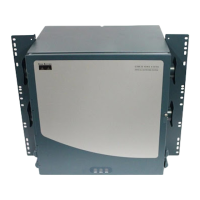6-17
Cisco ONS 15454 Procedure Guide, R5.0
August 2005
Chapter 6 Create Circuits and VT Tunnels
NTP-A183 Create a Unidirectional DS-1 Circuit with Multiple Drops
–
STS grooming node is [destination node], VT grooming node is [source node]—Creates the
VAP on the DS-1 circuit destination node. This option is available only if the DS-1 circuit
terminates on an EC1, DS3, DS3E, DS3i-N-12, DS3XM-6, DS3XM-12, or OC-N card.
• None—Choose this option if you do not want to create a VT tunnel or a VAP. This is the only
available option if CTC cannot create a VT tunnel or VAP.
Step 15 Click Next. In the Route Review and Edit area, node icons appear so you can route the circuit manually.
The circuit source node is selected. Green arrows pointing from the source node to other network nodes
indicate spans that are available for routing the circuit.
Step 16 Complete the “DLP-A96 Provision a DS-1 or DS-3 Circuit Route” task on page 17-97 for the DS-1
circuit you are creating.
Step 17 Click Finish. CTC completes the circuit and the Circuits window appears.
Step 18 In the Circuits window, click the circuit that you want to route to multiple drops. The Delete, Edit, and
Search buttons become active.
Step 19 Click Edit (or double-click the circuit row). The Edit Circuit window appears with the General tab
selected.
All nodes in the DCC network appear on the network map. Circuit source and destination information
appears under the source and destination nodes. To see a detailed view of the circuit, click Show
Detailed Map. To rearrange a node icon, select the node, press Ctrl, then drag and drop the icon to the
new location.
Step 20 In the Edit Circuit dialog box, click the Drops tab. A list of existing drops appears.
Step 21 Click Create.
Step 22 In the Define New Drop dialog box, create the new drop:
a. Node—Choose the target node for the circuit drop.
b. Slot—Choose the target card and slot.
c. Port, STS, VT, or DS1—Choose the port, STS, VT, or DS-1 from the Port, STS, VT, or DS1
drop-down lists. The card you chose in Step b determines the fields that appear. See Table 6-2 on
page 6-3 for a list of options.
d. The routing preferences for the new drop match those of the original circuit. However, if the
following options are available, you can modify them:
• If the original circuit was routed on a protected path protection path, you can change the nodal
diversity options: Nodal Diversity Required, Nodal Diversity Desired, or Link Diversity Only.
See Step 12 for the option descriptions.
• If the original circuit was not routed on a protected path, the Protection Channel Access option
is available. See Step 11 for a description of the PCA option.
e. If you want to change the circuit state, choose the circuit state from the Target Circuit Admin State
drop-down list. The state chosen applies to the entire circuit.
f. Check Apply to drop ports if you want to apply the state chosen in the Target Circuit Admin State
to the circuit source and destination drops. For the requirements necessary to apply a service state
to drop ports, refer to the Cisco ONS 15454 Reference Manual.
g. Click Finish. The new drop appears in the Drops list.
Step 23 If you need to create additional drops for the circuit, repeat Steps 21 and 22 to create the additional drops.
Step 24 Click Close. The Circuits window appears.
Step 25 Verify that the new drops appear in the Destination column for the circuit you edited. If they do not
appear repeat Steps 5 through 24, making sure all options are provisioned correctly.

